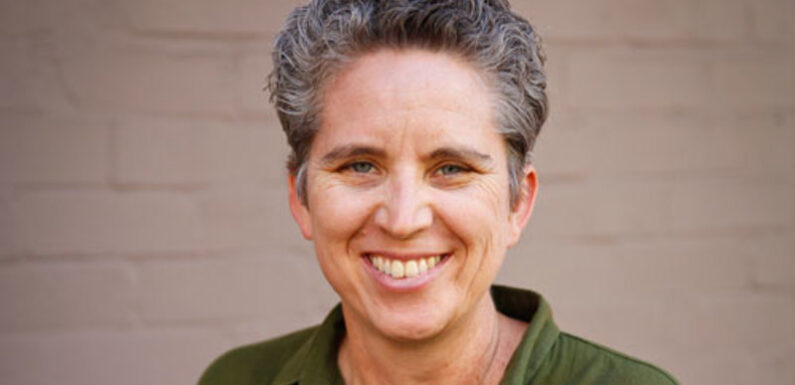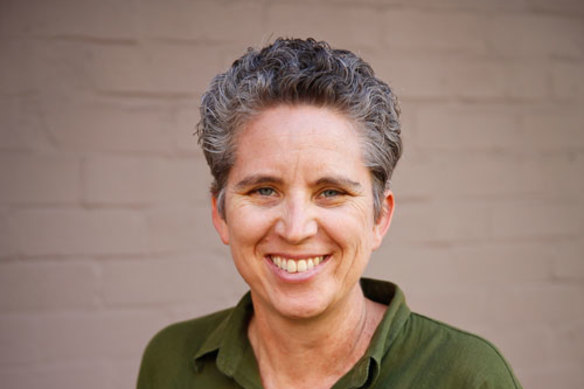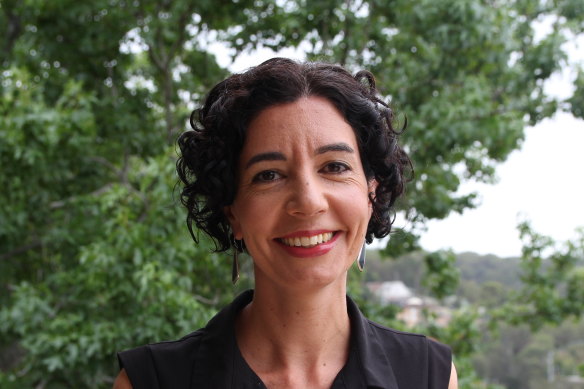
Save articles for later
Add articles to your saved list and come back to them any time.
When retired English teacher Alison Myers became an audio describer, one of her first assignments was describing a somewhat crowded sex scene in Australian crime series Underbelly. “My very first episode, there was a sex scene with two blokes and at least three women, and basically that was welcome to audio description,” she recalled.
Audio describers like Myers give blind, vision impaired people or those with learning disabilities an understanding of what is happening on a screen, stage or in an exhibition. The art of audio description is to paint a picture with words and weave them between dialogue without disrupting the narrative. The challenge lies in avoiding interpretation and not getting put off by graphic scenes, said Myers, audio description manager at captioning and audio description company The SubStation.
Retired English teacher Alison Myers had to describe a sex scene involving two men and several women in her first job as an audio describer.
“The sex scenes get interesting and it’s one of the problems with audio description because some describers get squeamish about these things, and you absolutely cannot because blind people are adults,” she explained. “If they’re watching Underbelly or they’re watching adult shows, they’re adults, they’ve chosen to watch this and they need to know what’s going on. It’s really important.”
But it’s not just sex scenes that can trip up audio description professionals. In an episode of the ABC’s Foreign Correspondent, Myers had to rap along with an anti-government Russian protestor.
“I’m not singing, but at the same time you can’t do that sort of thing deadpan,” she explained.
“You just need to sound like you’re interested in what’s going on because what we need to do is keep everyone in the moment.
“So it’s tone, emphasis, all that sort of thing. If it’s an exciting scene, you can’t do an action scene the same way you do a sex scene, the same way you do Bluey.”
For others, it’s finding the words to describe the indescribable. Freelance audio describer and trainer Fran Mathey was charged with the live description of the 2019 New Year’s Eve fireworks on ABC radio and used adjectives such as “rays”, “arcs” and “flashes” before making up something of her own.
The 2019 New Year’s Eve fireworks were uniquely described by an audio describer.Credit: Dominic Lorrimer
“For some reason I chose to describe the fireworks on the Sydney Harbour Bridge at that moment as ‘a glittery mohawk of bling’,” she said. “Fireworks and light shows never stop being exhilarating to describe!”
There are also the perils of becoming lost in translation, particularly when describing television for international audiences. A case in point is the definition of pants, which in the UK refers to underpants. Thankfully, for Mathey, both definitions applied in a recent description she wrote: “On the astral plane a cowboy rides past. He falls off his horse, gets to his feet and drops his pants.”
The nuances of all that’s weird and wonderful about television can also crop up.
Kevin Geldard, audio description team leader at Red Bee Media, recalls a staff online chat about whether a cyclops could wink or if it was actually blinking.
“Someone grabbed a dictionary definition to figure out that a wink was voluntary while blinking is involuntary, someone else suggested that other movements would indicate it was a wink, such as head tilting like a non-cyclops would do when they were winking, and then we got a little sidetracked by the idea that nobody’s ever really referred to human beings as non-cyclopses before,” he recalled.
Although audio description has been around for more than 30 years in Australian theatres, it is still a nascent industry within television.
It was first trialled in 2012 for 13 weeks on ABC, then again in 2015 for 15 months. This year ABC and SBS launched 14 hours of audio description content on each channel. Some streaming services, such as Netflix, Stan and Amazon Prime, also provide audio description.
Unlike past versions of audio description where graphic scenes have been glossed over, new content on SBS will be described in unflinching detail. This includes some of the channel’s signature erotic films including Blue Velvet, Body Double and Zola, said Victoria Hunt, manager of SBS Access Services.
Freelance audio describer Fran Mathey.
“Traditionally this type of content has aimed for neutral descriptions and delivery, but obviously this denies the intended audience part of the experience,” she said.
“Our bespoke approach aims to reflect a program’s themes and world view with distinct vocabulary, tone and mood which captures more fully what’s happening on screen.”
The increase in audio described content has resulted in a push for more people with blindness or low vision to provide the audio description. Edwina Gustafson, who is legally blind, has been a freelance audio describer for three months now and hopes more people from the blind community will join the profession.
“I feel it’s so important for the people with a disability to be creating things for their community,” she said.
“In life or in audio description, anywhere, I don’t want to be told what a sighted person sees. I can’t really relate to that, like the pattern on someone’s dress and the backdrop details of that.”
Ultimately, the uptick of audio described television is not just about better access to entertainment. Blind man Bruce Maguire, who is also lead policy advisor at Vision Australia, said it’s about inclusion.
“When my kids were growing up in the nineties, the early 2000s, I couldn’t participate with them in talking about the television programs that they were watching because there was no audio description,” he said.
“So as a blind father, I felt quite excluded and frustrated by the fact that I couldn’t share something that was really important to them as they were growing up.
“So audio description is a huge thing. It opens up a whole world of access that as people are blind or have low vision, we haven’t had, and which we should have.”
Find out the next TV, streaming series and movies to add to your must-sees. Get The Watchlist delivered every Thursday.
Most Viewed in Culture
From our partners
Source: Read Full Article


